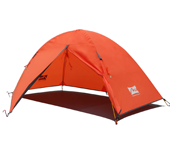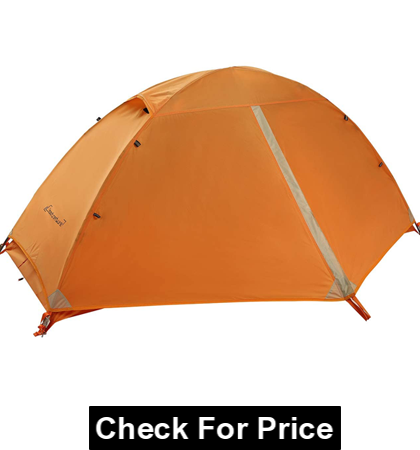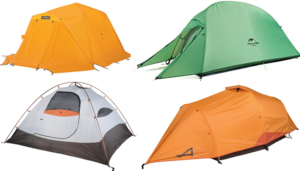You must go prepared for those fun camping and backcountry trips. If you are all by yourself, you need to be smart about what you carry, and among the important things is a tent. As the name indicates, backpacking tents are ideal for solo travelers, which is why these are also known as solo backpacking tents.
The tent needs to be strong enough to withstand the weather and offer enough protection. If you are confused about selecting the best solo backpacking tent, we have a guide below for your help. Also, we have reviewed five products that offer the best bang for your buck.
In a hurry? My favorite is this MSR Elixir 1-Person Lightweight Backpacking Tent. See it at Amazon.
# | Preview | Product | Features | |
|---|---|---|---|---|
Top Pick  | Clostnature 1-Person Tent for Backpacking CHECK PRICE | - Size: 1 Person - Material: Polyester, Aluminum - Brand: Clostnature - Color: Yellow - Closure Type: Hook & Loop - Waterproof: True | CHECK BEST PRICE | |
 | MIS Camping Tent CHECK PRICE | - Size: Medium - Material: Polyester - Brand: MIS - Color: Orange - Weight: 3.96lbs - Closure Type: Zipper - Waterproof: True - Shape: Dome | CHECK BEST PRICE | |
 | MSR Elixir 1-Person Lightweight Tent CHECK PRICE | - Size: 1-Person - Material: Fabric - Brand: MSR - Color: Red/Gray - Weight: 4.75lbs - Closure Type: Zipper | CHECK BEST PRICE | |
 | Kelty Late Start Backpacking Tent CHECK PRICE | - Size: 1-Person - Material: Nylon - Brand: Kelty - Color: Blue - Weight: 3.5lbs - Closure Type: Zipper - Waterproof: True - Shape: Round | CHECK BEST PRICE | |
 | ALPS Mountaineering Lynx 1-Person Tent CHECK PRICE | - Size: 1-Person - Material: Polyester, Aluminum - Brand: ALPS Mountaineering - Color: Clay/Rust - Weight: 3.97lbs - Closure Type: Zipper | CHECK BEST PRICE |
Reviewing Top 5 Solo Backpacking Tent
Clostnature 1-Person Tent for Backpacking
This is a solo backpacking tent that has been designed with care. The material is 210T Polyester, with PU 5000 coating. The product weighs just 3.7 lbs and is easy to pack, making it ideal for all adrenaline junkies.
Also, the tent is very easy to set up, while the mesh walls on the interiors make room for enough ventilation. A big door and vestibule make the tent more productive than usual options.
Pros
– Weighs just 3.7 lbs
– PU 5000 coating
– 210T Polyester material
– Vestibule
– Designed for fast pitching
– Aluminum poles
– Includes carry bag
Cons
– None
MIS MOUNTAIN INN SPORTS Camping Tent
This is a solo backpacking tent from MIS, which only weighs 3.96 lbs. Made of 100% waterproof polyester, the product is ideal for withstanding elements like rain and snow.
The footprint included in the package can work as a picnic blanket when needed, while other things included are pole clips, guy rope, and repair fabric—a great product for regular travelers who are on a budget.
Pros
– Made of 100% waterproof polyester
– Weighs only 3.96 lbs
– More room
– Multi-function Footprint
– Pocket included
– Repair kit included
Cons
– Not ideal for extreme weather
MSR Elixir 1-Person Lightweight Backpacking Tent
Ideal for backpackers and campers, this is a minimalistic tent that can fit a large mat inside and has enough room for a person. Among the unique features is the glow-in-the-dark zipper pulls, which enhance the use of the product.
The footprint is lightweight, and the product comes with color-coded poles for fast pitching. The mesh used on the interiors adds to the ventilation factor. If you are on a budget, this is a decent pick for beginners.
Pros
– Budget-friendly
– Glow-in-the-dark zipper pulls
– MSR Elixir footprint
– Fast pitching
– Mesh and solid fabric panels
Cons
– Slightly heavier
– Not the most durable of all
Kelty Late Start Backpacking Tent
Kelty Salida Tent is ideal for a couple of travelers. The tent can accommodate two people easily, and with a peak height of 40-inch and two aluminum poles, there is enough room inside the tent.
The floor sheet is made of 68-denier fabric, and thanks to the freestanding design, this tent can be set up in minutes. Considering that it just weighs 3.5 pounds, it is among the best tents that two people on a trip can share comfortably.
Pros
– Offers 29. 5 square feet of area
– Vestibule storage space
– Comes with aluminum poles
– Mesh interiors for ventilation
– 68-denier fabric for floor
– Waterproof
– Weighs just 3.5 Pounds
Cons
– Is a Three-season tent
– Slightly expensive
ALPS Mountaineering Lynx 1-Person Tent
This ALPS Mountaineering Lynx doesn’t require any assembly and can be used effectively for any weather. The polyester tent fly is water-resistant and offers UV protection, while the vestibule adds to storage space.
With eight zippers, the tent is pretty airy and feels comfortable inside. The product weighs 4 lbs, which is decent for one person to carry around, no matter the terrain.
Pros
– Easy setup
– Polyester tent fly
– UV protection
– Water-resistant
– Includes storage pockets and one vestibule
Cons
– Weighs more than similar tents
How to choose the best solo backpacking tent?
1. For someone who is walking for a heavy tent would make little sense for someone, a heavy tent would make it out solo backpacking tents is the weight. You need to be comfortable with the baggage. Do not look for bags that weigh more than four pounds, considering you will have other essentials.
2. The next critical aspect is the purpose. You can find both 3-season and 4-season solo backpacking tents but consider your usual adventures and take a call on this aspect. Solo 4-season tents cost a tad more but are more durable because of stronger fabrics. However, 4-season tents can weigh more because of heavy fabrics.
3. Installation and pitching should be considered too. If you are camping alone, you wouldn’t have a helping hand, and therefore, the solo backpacking tent needs to be designed for fast pitching. When the night is dark, or without extra help, struggle with a tent can be real.
4. Pricing, of course, is a factor for many buyers. Keep in mind that solo backpacking tents don’t cost a lot, but if you go for a known brand that offers a warranty on their products, you may have to pay more. Your tent is your biggest and most important gear for camping, and compromises are never worthwhile.
5. Another important aspect of choosing solo backpacking tents is the space. There are big enough tents to big enough tents, but again, consider the weight and what you expect from the product. For instance, if you are camping for days at a stretch, you need a more comfortable and bigger option with added space.
Consider the weather and terrains before you compare your options. Keep in mind that there won’t be an alternative out in the wild, and if you have unexpected rain or storm, a flimsy tent can disintegrate in no time. Decide on the solo backpacking tent, depending on how you usually plan your camping journey.
Frequently Asked Questions
1. How much to pay for a solo backpacking tent?
There is no one answer to that. You can find solo backpacking tents for as low as $50, but consider all other aspects, including durability and overall use. The last thing you would want is to be stranded somewhere with no protection from weather elements. Therefore, good solo backpacking tents should cost close to $100 at the least or more.
2. How to set up a solo backpacking tent?
Most solo backpacking tents come with aluminum poles, and these are often color-coded for easy setup. Make sure that you check the product’s pitching guide to find more, and before you take your tent outdoors, try setting it up in the backyard. Eventually, when you don’t have help, you need a tent that’s easy to pitch.
3. What features are most important? What’s the best material for a tent?
If you are buying a new solo backpacking tent, make sure that you check the materials. The tent should withstand the weather, so waterproof design and better ventilation are key pointers to consider. Most solo tents have one door, but you can find models with an added window for extra ventilation. Also, if you are traveling with someone, find a solo backpacking tent that can accommodate an extra person if need be.
Final word
Investing in the right tent is not just about the price but your security when nothing else is available. Make sure that you review all products that are within your budget and consider the pros and cons before finalizing the budget. Top solo backpacking tents can cost more, but eventually, that extra amount is definitely worth paying for the high-quality material and lighter weight.
Don’t forget to check the top five products listed above, each of which is selected for campers and travelers who like to keep their tent to themselves.




























